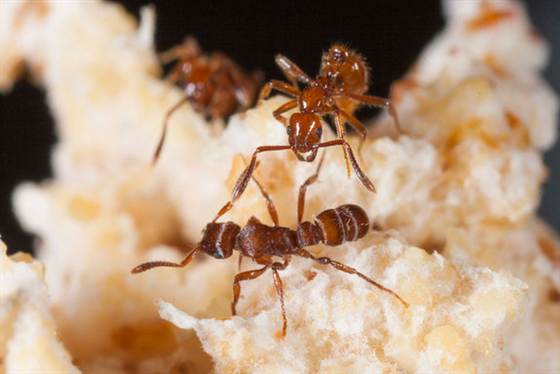Ants are absolutely fascinating creatures. Not only have they discovered farming and animal husbandry thousands of years before us (sometimes even using bacteria to grow gardens), they also conduct executions for the good of the colony, follow Fermat’s principle of least time, and as it has been shown now, draft parasite ants as mercenaries.
Just like medieval cities sometimes recruited expensive contingents of mercenary soldiers to ward off invaders, farmer ants sometimes recruit parasite warrior ants to fight for them, as it is neatly illustrated by this video.
Entomologists investigated a type of ants called Sericomyrmex, which raise fungus in gardens. They are what you would call farmer ants, living on peacefully in their day to day activities. But they have a problem with a type of parasitic ants named Megalomyrmex. These species has cunning queens which stealthily enter and colonize the gardens of Sericomyrmex and can feed on their offspring and their fungus for years before they are detected and stopped. They even cut off the wings of the virgin queens of Sericomyrmex, thus halting the spread of further colonies.
Evolutionary biologist Rachelle Adams at the University of Copenhagen has studied this stunning phenomena for over 10 years; she noticed that at some point, these parasites can make up to 80 percent of the entire colony, which doesn’t really seem to make any sense.
“This prompted me to question why this might be, leading me to focus my collecting efforts on this particular system,” Adams said.
So she put ants to the test: she took the farmer ants and exposed them to another common threat to them: Gnamptogenys. This is also a type of parasitic ant, but they’re way more threatening: they come, pillage the fungus gardens and destroy everything. However, when exposed to this threat, while the farmer ants went into hiding, the Megalomyrmex rose up and fought the invaders off – and then it hit her! Sometimes, they are not truly parasitic, but instead, are fed and tolerated in order to protect the colony.
“The guest ants are the better of two evils,” Adams explained. “If the raiders were not a threat, then the guest ants would only be a burden to the host colony.”
Indeed, this theory was confirmed by further research – she noticed that invaders only attack colonies without ‘mercenaries’.
“If we studied just the farming ants and the guest ants, we would have missed this important discovery and concluded the guest ants are simply parasites,” Adams said. The researchers compared this tradeoff to sickle cell anemia, a hereditary blood disease that can cut lives short but also gives people resistance against malaria.
The research team also highlighted that Megalomyrmex conducts a type of chemical warfare.
“The raider ants attacked by the Megalomyrmex were often attacked by their own nest mates,” Adams said. “This suggests that the guest ant venom disrupts the recognition system of the raiders, causing sisters to attack and kill one another.”
This just goes to show that relationship between ants, and likely other insect species are simply far more complex than we have judged them so far. We should keep in mind that every additional interaction brings an entirely new complexity and should change the way we perceive the situation.
The scientists detailed their findings online Monday in the journal Proceedings of the National Academy of Sciences.










